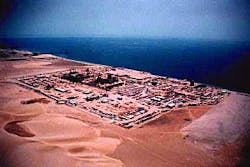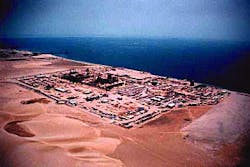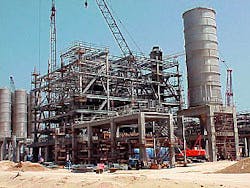Qatar Chemical Co. Ltd. (Q-Chem) is building a grassroots petrochemical facility that will almost double the current 525,000 tonne/year (tpy) ethylene capacity at the Mesaieed industrial area in Qatar (Fig. 1).
Its commercial operation, planned for third quarter 2002 start-up, will coincide with several other large ethylene-capacity expansions in the Middle East and Asia (OGJ, Apr. 23, 2001, p. 61). The facility will produce ethylene, polyethylene, and hexene-1.
Other support and utility units include feed treatment, air, nitrogen, seawater cooling, waste treatment, docks, warehouses, and buildings. The company will generate all utilities on site except electricity and desalinated water.
Q-Chem is a joint venture between state-firm Qatar Petroleum (51%) and Chevron Phillips Chemical Co. LLC (49%).
It built the plant in Mesaieed, said Tom Paulson, senior project manager, Q-Chem and NGL-4 projects, because of its access to markets and assured Qatar feedstock supply. The company sees its low-cost ethane feedstock as an advantage over naphtha-based plants in the Eastern Hemi sphere.
It will use its ethylene production internally, and Chevron Phillips will market the polyethylene and hexene-1 products to Europe, Asia, and the Middle East.
Plant design
Annual production capacities at the complex include 500,000 tpy (1.1 billion lb) of ethylene; 460,000 tpy (1 billion lb) of polyethylene; and 47,000 tpy (100 million lb) of hexene-1, a key feedstock in the manufacture of high-density polyethylene (HDPE) and linear low-density polyethylene (LLDPE).
Q-Chem will use Kellogg Brown & Root's ethylene technology and Chevron Phillips's slurry loop polyethylene technology. It will use Chevron Phillips's metallocene catalyst system. The complex will have the first commercial application of Chevron Phillips's hexene-1 manufacturing and catalyst technology, said Paulson.
Figs. 2 and 3 show construction of the polyethylene and hexene-1 facilities.
The feed to the new plant will be a sour, ethane-rich stream from the NGL-4 plant, currently under construction by Qatar Petroleum. Polyethylene product quality will meet the standards of Chevron Phillips's Marlex polyethylene requirements.
The NGL-4 project consists of new NGL fractionation and treating facilities at Mesaieed and upgrading of existing facilities in Dukhan and Mesaieed. Qatar Petroleum has timed the completion of this project for second quarter 2002 to provide ethane to Q-Chem's new cracker.
The plant design has had no unusual environmental considerations. "We are designed to meet or exceed all Qatar regulations, which are similar to US Environmental Protection Agency requirements," said Paulson. In its permitting process, the company completed an extensive environmental impact assessment prior to submitting its permit application to Qatar environmental agencies.
The Q-Chem facility treats all its own waste except for solids, said Paulson. The wastewater treatment plant and the incinerator are key facilities that help with environmental management of wastes.
Project engineering
Brown & Root carried out the feasibility study for Q-Chem's petrochemical complex in 1997. In 1999, Q-Chem awarded a joint venture of Houston's Kellogg Brown & Root (KBRT) and Paris's Technip the $850 million engineering, procurement, and construction (EPC) contract.
Construction began in fourth quarter 1999 with site preparation. Foundation pours began third quarter 2000.
The main contractors for KBRT are India-based Dodsal Ltd. for ethylene, Athens-based CCC (Consolidated Contractors Co.) for polyethylene and hexene-1, Dubai-based Chicago Bridge & Iron Co. NV (CBI) for tanks, and Doha-based Amcon Ltd. for dock and seawater intake projects.
At peak construction, the construction workforce will number about 7,000. Q-Chem is hiring plant personnel staff, expected to number 490. Staff training commenced in the third quarter of 2001.
For unit control, the plant will use Honeywell DCS (distributed control system). Only the polyethylene unit will use advance process controls.
By start-up of the project in third quarter 2002, Q-Chem's capital investment will have reached $1.2 billion.



